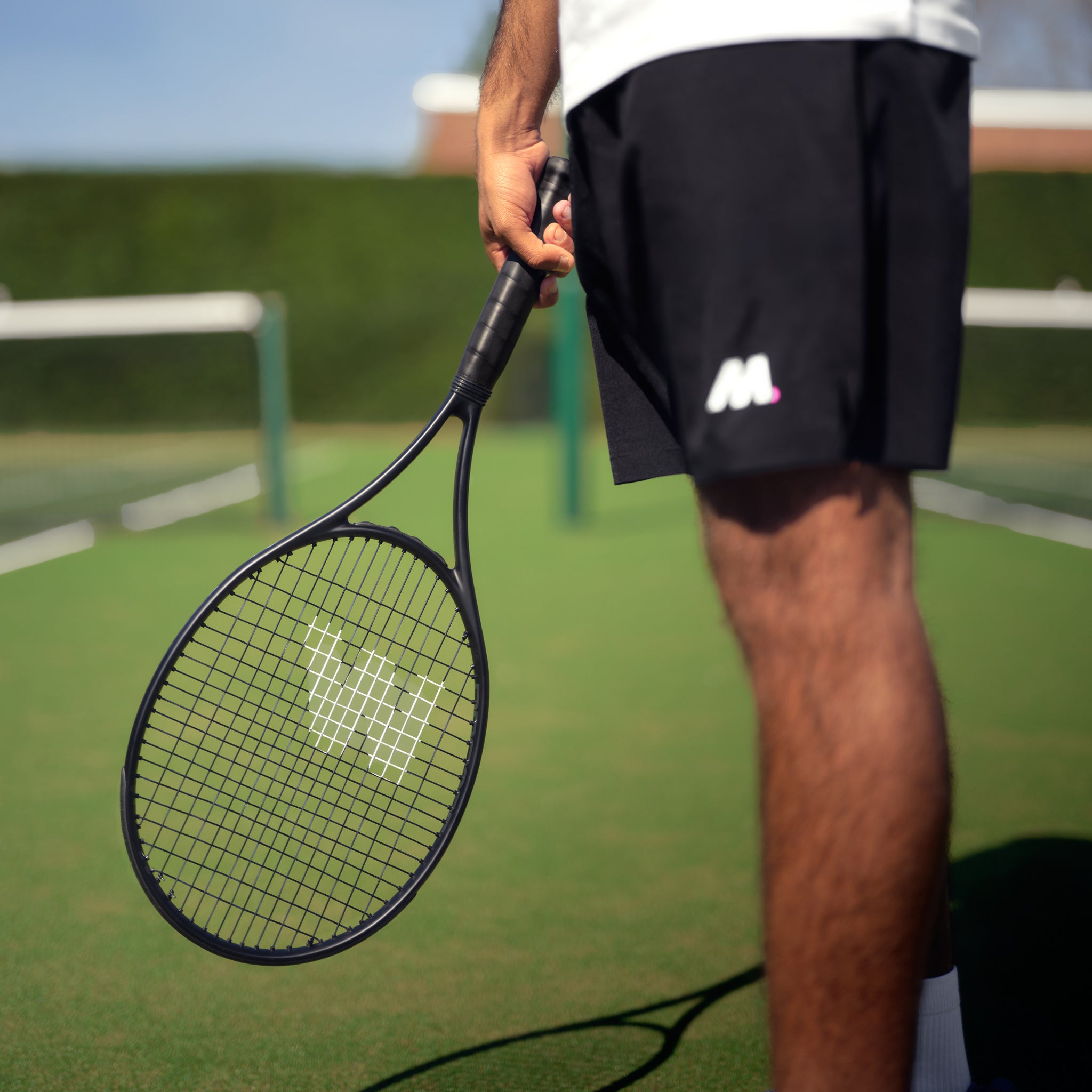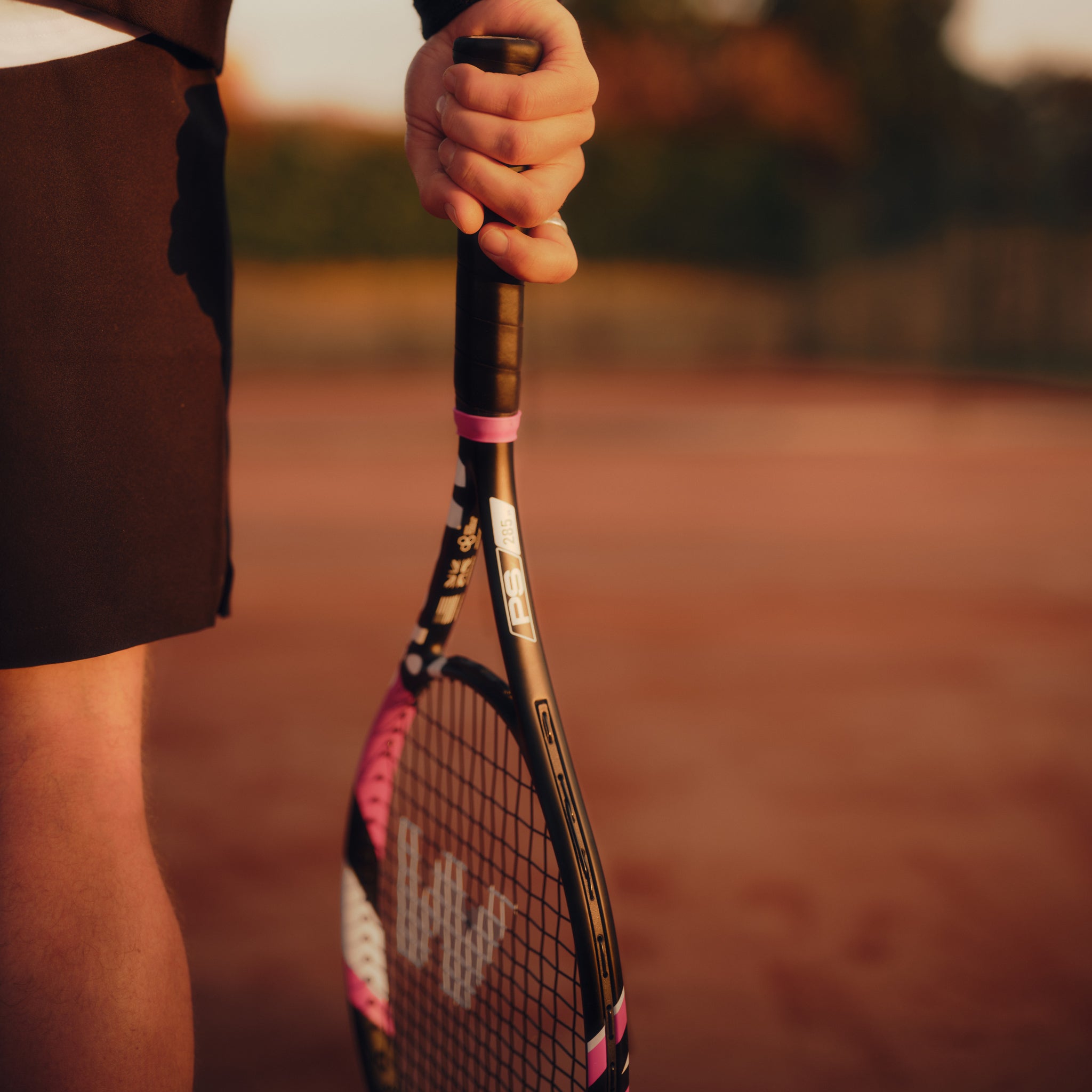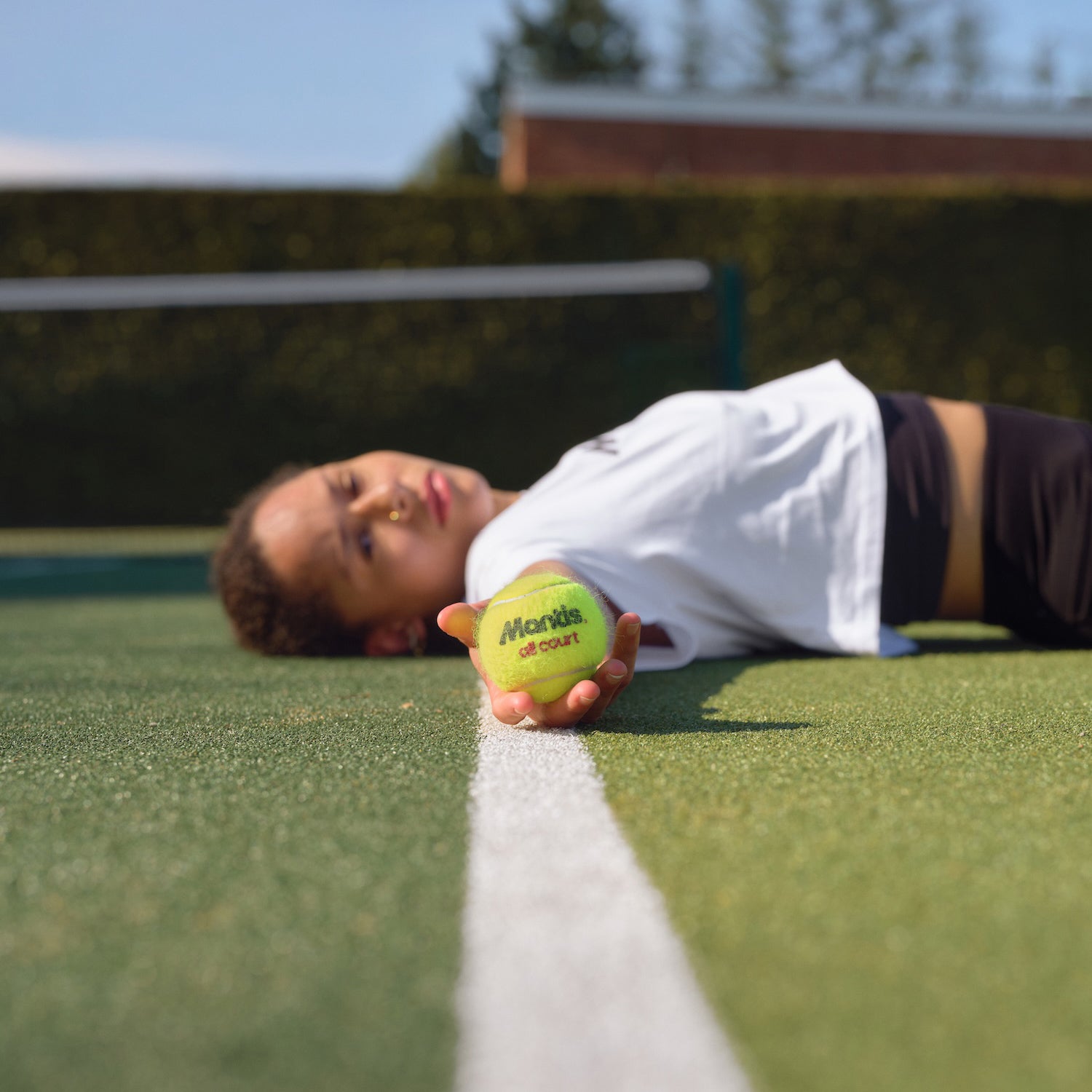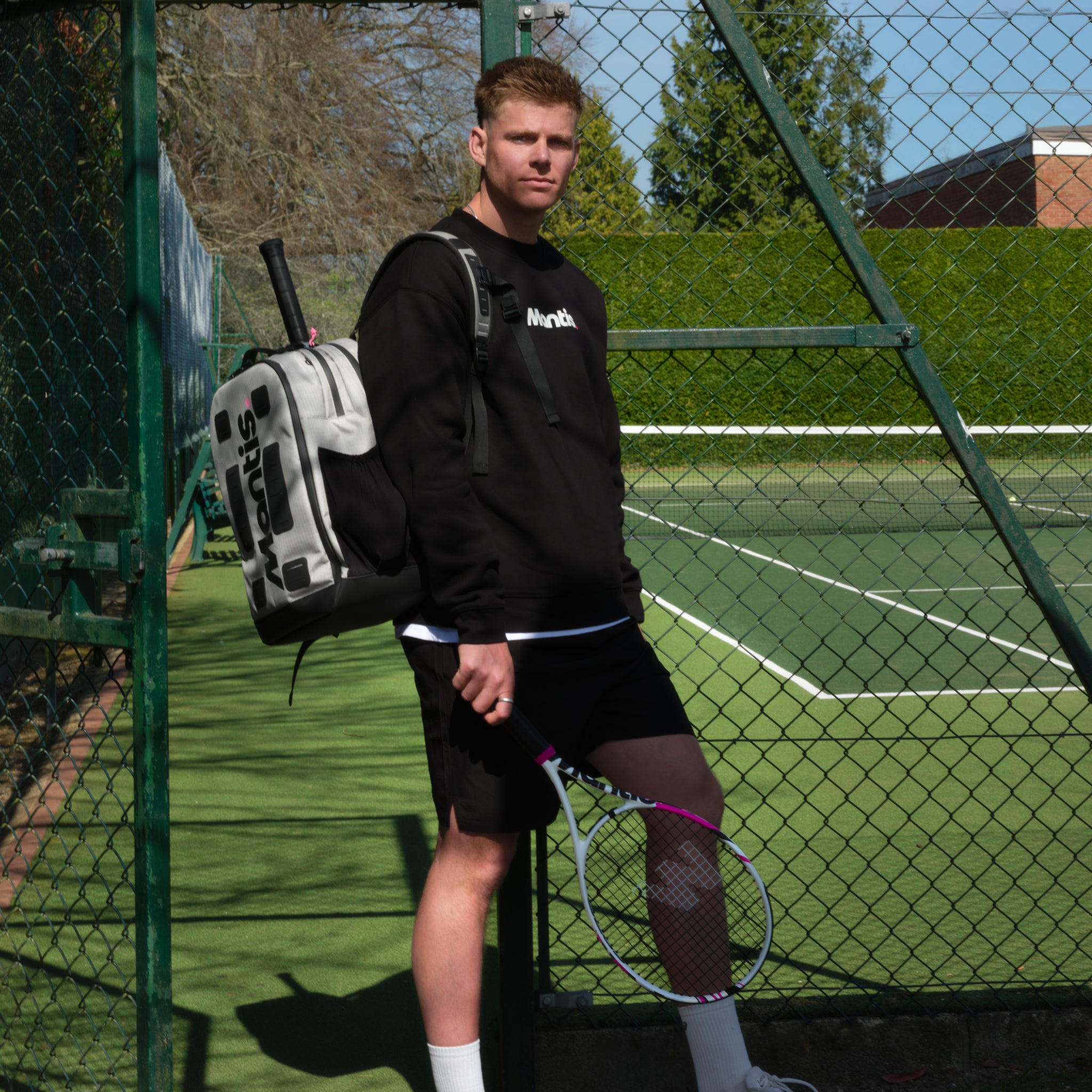
At Mantis, we think of green tennis balls as the final stepping stone before a player graduates to the standard yellow ball. Known as 'Stage 1' balls in progressive tennis coaching, they're designed to be 25% slower than a regular ball.
This deliberate design creates a lower, more predictable bounce. The real magic here is the extra split-second it gives players to get their feet set, prepare their swing, and connect with the ball cleanly. It’s all about building confidence and grooving technique on a full-size court.
What Makes Green Dot Tennis Balls So Effective?
Here at Mantis, we see player development as a carefully managed journey. Green dot balls are crucial for that journey, perfectly bridging the gap for players who are hitting the smaller orange balls well but aren't quite ready for the zip and bounce of a standard yellow ball.
The whole idea behind the green dot ball is to slow the game down just enough. This slight reduction in pace opens up a world of benefits for players who are starting to refine their skills:
- Longer Rallies: The ball stays in play more easily, which means more hitting! This is fundamental for developing rhythm and muscle memory.
- Refined Technique: With that extra moment to prepare, players can really focus on their footwork and swing mechanics instead of just reacting frantically.
- A Huge Confidence Boost: Nothing feels better than hitting a good rally. When players start to consistently control the ball and construct points, their belief in their own ability skyrockets.
To put it all into context, let's compare the different stages of tennis balls side-by-side.
Progressive Tennis Ball Comparison
| Ball Type | Compression Level | Approximate Speed Reduction | Typical Age Group |
|---|---|---|---|
| Red (Stage 3) | Low (75% Slower) | 75% | 5-8 years |
| Orange (Stage 2) | Medium (50% Slower) | 50% | 8-10 years |
| Green (Stage 1) | Medium-High (25% Slower) | 25% | 9-11 years & Adult Beginners |
| Yellow (Standard) | Full Compression | 0% | 11+ years |
This table clearly illustrates how each ball is designed to match a specific stage of physical and technical development, allowing skills to be built up layer by layer. The green dot ball is that vital final stage before players are ready to take on the full game.
The real beauty of the green dot ball is that it creates a realistic but forgiving playing environment. It lets players start thinking about how to play a point—using strategy and moving their opponent around—skills that are almost impossible to learn when the ball is just coming at you too fast.
How Green Balls Actually Change the Game on Court
So, what does it really feel like to play with a green dot tennis ball? Mantis created these balls with reduced compression, a simple tweak that completely changes the dynamic of a match.
This design deliberately slows things down. That might sound counterintuitive, but it gives players a crucial extra split-second to set their feet, prepare their swing, and make solid, confident contact with the ball.
Keeping You in the "Hitting Zone"
One of the biggest wins with a green dot ball is its lower, more predictable bounce. It consistently brings the ball into that perfect hitting zone—right around waist height—which is the sweet spot for grooving clean, efficient groundstrokes.
This is huge for preventing bad habits. Players aren't forced to swat defensively at balls flying up around their shoulders. Instead of just reacting to a wild bounce, they can move with purpose.
Think of it as playing in slow-motion. The green ball gives you the time to see what’s happening, process it, and execute your shot properly. It turns what could be a frantic, error-filled exchange into a constructive rally where you can actually work on your game.
It’s in this controlled environment that proper technique truly starts to click.
Building Rallies, Building Confidence
The slower pace naturally leads to longer, more satisfying rallies. As soon as players can keep the ball going back and forth, they start to grasp the fundamentals of point construction, court positioning, and recovery.
Every shot that goes over the net builds a little more confidence, making the sport far more fun and less daunting. The focus shifts from merely trying to survive a point to actually playing it.
- Better Timing: The ball’s slower flight path makes it easier to sync up your footwork and swing into one fluid motion.
- Smarter Shot Selection: With more time to think, players can begin to make conscious decisions about where to place the ball and why.
- Improved Technique: A coach can offer feedback that a player can instantly apply without feeling overwhelmed or rushed by the speed of the game.
Ultimately, green dot tennis balls are about making practice more productive. They slow the game down not to make it easy, but to make learning effective for any player serious about getting better and falling in love with tennis.
So, Who Are Green Dot Balls Actually For?
Most people immediately think of junior tennis when they see a green dot ball, and they're not wrong. But their true value reaches far beyond the junior circuit. At Mantis, our gear is designed to support players at every single stage, and this ball is a perfect example of that ethos. To get a feel for the entire developmental journey, check out our full range of Mantis tennis balls and see how each one fits into the puzzle.
The classic user is, of course, the junior player. We're typically talking about kids aged 9-10 years old who are moving on from the smaller court and orange balls. They've got the basics down but need something that lets them play on a full-sized court without being overwhelmed by the pace and high bounce of a standard yellow ball.
It's Not Just About the Kids
Here's the thing: pigeonholing green dot balls as "just for juniors" is a huge mistake. They are an absolutely brilliant tool for adult beginners, who often get discouraged when a standard yellow ball flies past them before they can even get their racquet back. A green dot ball completely changes that early learning experience.
- Adult Beginners: It helps new adult players get rallies going from day one. This isn't just about hitting balls; it's about learning technique properly and, most importantly, discovering how much fun tennis can be.
- Intermediate Players: You’ll often see coaches pull out a basket of green dot balls to help more advanced players drill down on a specific part of their game. That slightly slower flight path is perfect for high-volume, focused repetition.
- Players Returning from Injury: Easing back onto the court after an injury can be tricky. Green dot balls are a great way to start hitting again without putting too much strain on recovering joints and muscles.
A fantastic use for these balls is skill refinement. Whether you're trying to master a tricky volley or get your service return timing just right, the green dot ball creates the perfect conditions for deliberate practice. It slows things down just enough to let your brain and body connect.
When it comes down to it, the "ideal player" isn't defined by age at all. It’s about anyone who needs a controlled, confidence-inspiring experience to help them improve and enjoy the game more.
The Real Advantages of Training with Green Balls
Using green dot tennis balls in your training sessions brings some pretty clear and immediate benefits, something we've built our whole coaching philosophy on here at Mantis. You can check out our full range of Mantis training aids to see how our gear supports players at every level. The biggest win, though, is how they help players have longer, more meaningful rallies right from the get-go.
When you can hit more shots in a single rally, you're getting more practice. Simple as that. This repetition is absolutely key for building muscle memory and getting a feel for how to construct a point, not just how to hit a ball. As players realise they can keep the ball in play more consistently, their confidence shoots up, turning what could be a frustrating hour into a genuinely productive one.
Safer for Developing Players (and a Boost for the Brain)
The softer compression of green dot balls gives them another massive advantage: they're much kinder on the body. The reduced impact means less shock and stress on a player’s developing arm and shoulder joints, which is a big deal. This is especially important for junior players whose bodies are still growing, but it’s just as valuable for adult beginners who are still getting used to the physical side of the game.
This focus on player well-being is vital, particularly in a well-established market like the UK's. With the UK lawn-tennis balls market valued at around £36 million in 2023, there's a clear and steady demand for quality equipment. The market has bounced back well after recent disruptions, showing just how popular the sport is and why we need gear that supports players for the long haul. You can get a feel for the industry at racketbusiness.com.
It's not just about the physical side of things; there's a powerful psychological edge, too. The extra control and higher success rate simply make tennis more fun and way less frustrating. This enjoyment is what keeps players motivated and coming back to the court, ensuring they stick with the sport long enough to really improve.
At the end of the day, the goal is to help people fall in love with tennis. By making the game more approachable and rewarding from the start, green dot balls help build a solid foundation not just for a player's technique, but for a lifelong passion for the sport.
How to Select Quality Green Dot Tennis Balls
Picking the right green dot tennis balls really matters. You might think they're all the same, but we believe there's a world of difference between a good ball and a bad one. To give a developing player the best chance, it’s worth sticking to reputable brands that meet official ITF standards for things like weight, size, and compression.
A quality ball gives you a consistent, predictable bounce and feel off the strings, which is exactly what you need when you're working on your technique. Durability is a big factor too – nobody wants balls that go flat after a couple of sessions. For some extra tips, check out our guide on how to keep tennis balls fresh to get the most out of your purchase.
One of the main choices you'll face is whether to go for pressurised or pressureless green dot balls. Each has its place.
Pressurised balls feel much more like a standard yellow ball – they’re livelier and more responsive, making them perfect for practice matches. Pressureless balls, on the other hand, are the tough ones; they last for ages and keep their bounce, which is why coaches love them.
Pressurised vs Pressureless Options
Let's break that down a bit further so you can figure out what’s best for you.
-
Pressurised Balls: These are your go-to for players who want that authentic match-play feel. They have a higher bounce and feel lighter on the racket, but they do lose their pressure and go soft over time.
-
Pressureless Balls: Think of these as the workhorse of the tennis court. Built with a solid rubber core, they simply don't go "flat." This makes them the perfect choice for filling up a coaching basket or a ball machine.
Don't forget to look at the felt quality. A good, durable felt cover will stand up to plenty of hitting without fluffing up too much and slowing the ball down. It’s also interesting to see what’s happening in the wider market. The average import price per tennis ball in the UK shot up by about 32% in 2022, with China becoming a major supplier.
Ultimately, choosing a quality ball from a brand like Mantis ensures you're getting great performance and real value for your money.
Sustainability in the Tennis Ball Industry
In the world of tennis, we're waking up to our environmental responsibilities, and it's not a moment too soon. At Mantis, we're convinced that top-tier performance and sustainability aren't mutually exclusive. Our approach to designing equipment, especially our green dot tennis balls, is built on this very principle.
The humble tennis ball, as it turns out, has a pretty significant environmental footprint. It’s quite staggering to think that a standard ball can sit in a landfill for up to 400 years before it even begins to break down.
This single fact is pushing a much-needed change throughout the industry. Here in the UK, where players and suppliers are more environmentally conscious than ever, the demand for greener options is growing fast.
A Greener Approach to the Game
Innovation is the only way forward. We're seeing some fantastic changes across the board, from balls being made with recycled materials to smarter, more sustainable packaging. Mantis is proud to be at the heart of this movement, creating products that play brilliantly while respecting our planet.
Thinking about sustainability in tennis is part of a much bigger picture.
The core idea is simple: the equipment that helps players develop their passion for tennis shouldn't harm the planet. By embracing eco-friendly practices, we can ensure the sport remains healthy for future generations.
This conscious approach shows that high-performance gear and environmental care can—and must—go hand in hand in modern sport.
Answering Your Questions About Green Dot Tennis Balls
Here at Mantis, we talk to players, parents, and coaches all the time, and a few questions about green dot tennis balls pop up again and again. Let's clear up some of the common queries so you can feel confident you're using the right gear.
What Age Is a Green Dot Ball For?
The usual guideline is for players aged 9-10, but that's really just a starting point. The true test isn't about age; it's about ability.
A much better way to judge is to watch them play. If a young player can comfortably rally and serve with an orange dot ball from the full baseline, they're almost certainly ready to move up to green.
Can Adults Use Green Dot Balls?
Yes, and they absolutely should! We can't recommend them enough for adult beginners. Starting with a ball that's a bit slower and has a lower bounce makes the initial learning curve so much less frustrating.
They're also a fantastic tool for seasoned players. If you're working on a specific part of your technique or easing back onto the court after an injury, the slightly reduced speed gives you that extra split-second to get it right.
It's worth remembering that durability can differ. Pressureless green dot balls are tough and built to last, which is why you see them in coaching baskets—they keep their bounce for ages. The pressurised ones feel a bit more like a standard yellow ball but, just like them, they will go soft over time.
Ready to help a player take the next step in their tennis journey? The team at Mantis designs equipment to support development at every stage. Explore our full range of high-performance tennis gear at https://mantissport.com.










